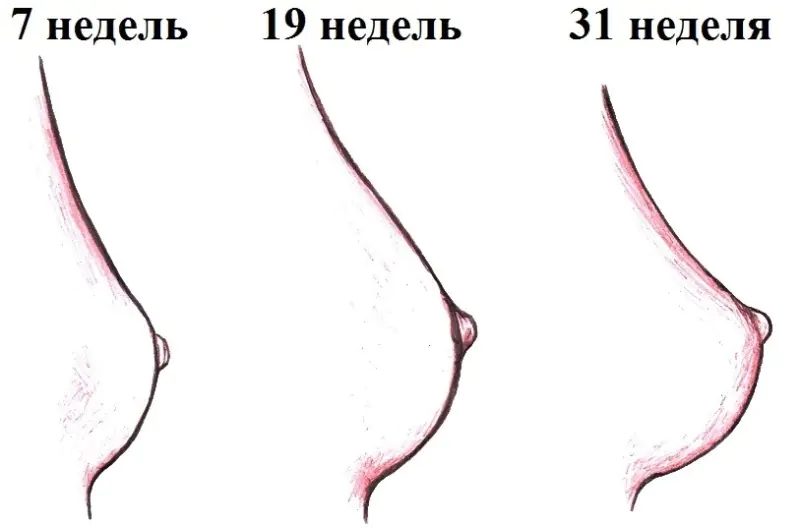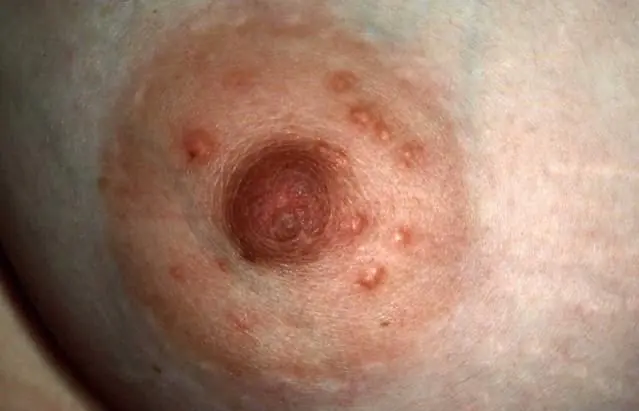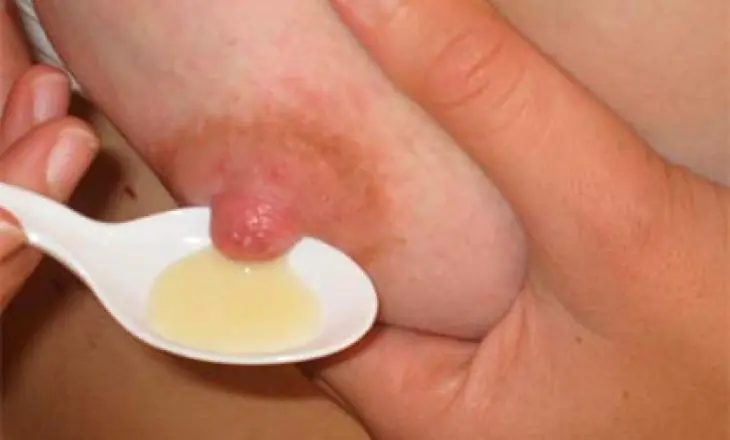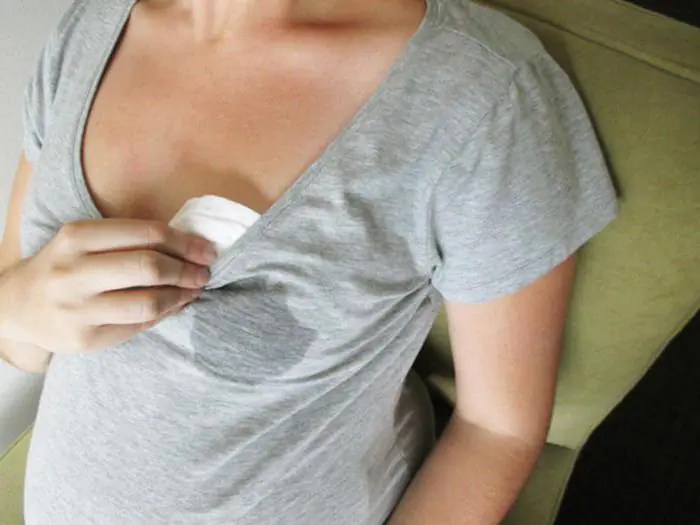Changes in the breasts during pregnancy are not only the norm, but I also have the opportunity to learn about the processes in the body according to the period. For example, by the condition, color and size of the nipple during pregnancy, you can find out the amount of the hormone, whether the pregnancy is proceeding normally, and how the baby is developing. Nipples during pregnancy are a conditional indicator of the norm and anomaly of all ongoing processes.

Nipple sensitivity
An increase in nipple sensitivity is observed long before the woman becomes aware of her situation. In part, this change occurs due to the fact that the amount of progesterone and prolactin in the blood increases. Estrogen, which is now in slightly smaller quantities, does not block the effect on the mammary glands of pregnancy hormones, which are now in slightly smaller quantities in the blood.
The manifestation of nipple sensitivity is expressed in the form of swelling, but characteristic manifestations can also occur on other sides. Thus, one of the first manifestations of a normal pregnancy is considered to be an increase in the sensitivity of the nipple area, the nipple itself. This sensation literally irritates a pregnant woman: the most gentle touch to the snowy, swollen skin of the nipple causes discomfort and provokes a surge of aggression and irritability.
In most women, the nipples acquire hypersensitive sensations characteristic of PMS, so at this stage many girls are unaware of anything, designating this as a sign of premenstrual syndrome. Visible changes are observed much later, when a pregnancy test shows two lines.
But when a woman is aware of the situation, then the sensations become more colorful: the nipples hurt at the slightest pressure or touch. It is recommended to change your current bra to a more spacious and comfortable one. The cup of the bra should be even, smooth, made of natural fabric and without seams that will irritate the nipples with existing decorative elements. Doctors recommend constantly wearing underwear, regardless of bust size, while at the same time placing pieces of fabric in the lower part of the cup that will raise the breasts slightly upward.
Air baths have a beneficial effect on the nipples, reducing soreness. Every day you can use air baths for 15 minutes before or after bathing. This will help harden the mammary gland, preparing it for breastfeeding.
Swelling of the nipples
The swelling of the nipple zone occurs in parallel with how the entire breast increases in size. The swelling, which initially causes pain, stabilizes after three months, the woman notes a decrease in discomfort, but the mammary gland is still enlarged in size.

Doctors recommend monitoring how your breasts swell: if they begin to deflate during the first trimester and sensitivity has disappeared, this is a reason to seek help from a gynecologist. Perhaps such a change is the first alarming sign of a decreased pregnancy hormone, which threatens miscarriage or fetal death.
Swelling of the nipples is most often observed during the first trimester, when the body produces the most intense progesterone. Due to the fact that hormones increase every minute, the mammary gland becomes large and swollen. The woman notes swelling of the nipple itself, which literally becomes stretched and feels very thin to the touch. The skin, when stretched, does not have time to adapt to the new dimensions, and therefore, against the background of such a change, the manifestation of itching of the skin is also noted.
The greatest sensations of discomfort are observed in the first trimester and before childbirth. The rest of the time, the breasts of the pregnant expectant mother remain swollen, but no pain symptoms are noted.
Darkening of the nipples
A change in nipple color is also a possible manifestation that a woman notices later in pregnancy. Progesterone, which now provides the child with the necessary life support, the required amount of elements necessary for growth, provokes changes in the nipple, which becomes darker under the influence of the hormone.
However, if no changes in color have occurred, you should not think that this is a pathology. Perhaps this feature is due to the individual genotype of a woman who naturally has fair hair and skin. As a rule, if before pregnancy the nipples are very light, barely distinguishable from the main color of the entire skin of the breast, then during pregnancy a woman will not notice any special differences, as, for example, in girls with dark skin.
This feature is partly due to melanin, which is present depending on the genotype and skin type, and partly the absence of a change in nipple color is due to the fact that the action of prolactin does not change the concentration of melanin substances in the juice itself. But in any case there is no need to talk about pathology.
Changes in the nipples and color are observed at the same time as the stripe from the navel to the woman's pubic bone darkens. Most often, visible changes occur in the last months of gestation.
Montgomery tubercles
Blistering formations in the form of pimples near the nipple are the so-called Montgomery tubercles, which develop during lactation and pregnancy. This development is due to the same hormone for pregnancy, as well as oxytocin, which is produced in large quantities before the birth itself.

It is with the onset of fertilization that a large number of pregnant women note an increase in the size of such formations, which causes fear and concern. It is believed that such tubercles are of particular importance during pregnancy and lactation. The purpose of such formations:
- The release of a special secretion that provides antibacterial protection to the nipple and breast during pregnancy or menstruation.
- Moisturizing the nipple halo, which becomes “waxed” to the touch. This is a normal phenomenon; moreover, this property is extremely necessary when preparing the nipple for lactation.
- Helps the baby quickly get used to the breast. It is these tubercles that form a special secretion, which the baby distinguishes by smell in priority order than the smell of milk.
Such tubercles begin to swell and increase in size in some women in the first week of pregnancy. This sign is the main one for most gynecologists, who determine both the timing of pregnancy and its normal course. However, if changes do not occur for a long time, there is also no need to worry; perhaps such changes will appear during lactation.
In 10% of women during pregnancy and lactation, Montgomery tubercles do not stand out and do not develop. This is explained by the individual characteristics of the body. However, this factor does not affect lactation.
Montgomery's bumps, which enlarge and swell along with the nipples and the entire breast, are not a cause for concern. However, if they become reddish, pink, hurt when touched and there is itching, burning, then this is a cause for concern and additional consultation with a gynecologist.
Treatment of pathological formations on the chest, including inflamed Montgomery tubercles in a pregnant woman, is carried out exclusively by a doctor who is managing the pregnancy in the antenatal clinic. Since the range of drugs during pregnancy and lactation is limited, the most acceptable and safe one is selected from all possible options. The drugs are usually used homeopathically, with herbs (herbal remedies).
Restless nipples during pregnancy should cause redness, swelling, pain and tingling. Discharge of a nonspecific greenish or pink tint should also alert you.
Colostrum release
Since the main task of the mammary glands in a woman’s life is to feed the child and provide him with proper natural nutrition, the supply of colostrum and milk is one of the most important issues that concern most women in an interesting position.
The release of colostrum occurs from the moment of concentration of prolactin in the mammary gland. Throughout pregnancy, its concentration gradually increases, and at the same time prolactin levels also increase, which ensures the necessary supply of milk in the future after childbirth.

A woman can notice the first signs of existing colostrum at 5,6 or 7 months of pregnancy. However, if this does not happen, there is no need to worry: the amount of colostrum is limited; for feeding the baby in the first three days, it is a few drops of colostrum that envelop the walls of the stomach. Colostrum is not milk that comes in large quantities, it is a kind of concentrate that helps the baby go through the adaptation period.
After birth, the baby is put to the breast not only for the purpose of feeding, but also for hormonal exchange between mother and child. The first drops of milk help the baby to understand that his mother is nearby, and the mother to fully experience the first minutes of motherhood. At this moment, oxytocin is produced, which helps to contract the uterus and stimulates milk production in the future.
Nipple stimulation
Many gynecologists recommend nipple stimulation throughout pregnancy to ensure that lactation continues without complications. However, nipple stimulation must be carried out carefully, since this procedure may cause contraction of the uterus. Normally, if there is no threat of miscarriage, then even constant stimulation cannot provoke premature birth, but if a woman is at risk of premature birth, then stimulation can be carried out after consulting a doctor.
What is nipple stimulation and why is it needed? First of all, stimulation is carried out so that the nipple is ready for lactation. A woman must remember that the nipple is grasped completely, most of it under the child’s lower jaw, the upper lip half grasps the nipple from above. If a child takes the breast incorrectly, cracks appear that bleed and hurt for a long period of time.
Nipple stimulation during pregnancy:
- contrast shower every morning, while the coldest water should not be below room temperature;
- wiping the nipples with a harsh cloth, preferably from unrefined flax;
- pulling and gently rolling the nipple forward, clockwise and counterclockwise.
From the moment the egg is fertilized and implanted in the uterine cavity, hormonal changes begin in the woman’s body, which will contribute to the preservation of pregnancy and its successful development. Previously released hormones change their concentration (progesterone and estrogen are produced more actively), which is expressed in different manifestations. The breasts are one of the first to react to hormonal changes. Very often, it is changes in the breasts and nipples that prompt a woman to think about the possibility of conception.
The breast begins to react to pregnancy from 10-14 days after conception, that is, virtually immediately after implantation of the egg. Moreover, both the breasts in general and the nipples in particular change. And this process lasts throughout the entire period of bearing the baby.
How nipples change during pregnancy:
One of the very first signs of pregnancy is increased nipple sensitivity. This feeling begins to simply irritate the woman: any touch to the nipple causes not only discomfort, but also infuriates her. Meanwhile, many women’s nipples become hypersensitive before each period, so often at this stage they still have no idea about anything, regarding this symptom as a manifestation of premenstrual syndrome.
But when you are already aware that you are pregnant, and your nipples hurt when pressed or touched, then it is better to immediately change your bra to the simplest and most comfortable one. The cup should be perfectly flat and smooth - without seams or decorative elements that irritate the nipples. Some doctors recommend placing pieces of coarse fabric in the cups, which will prepare the breasts for future feeding, and at the same time reduce their sensitivity and soreness.
Air baths will also have a beneficial effect on the chest and reduce soreness. Yes, and my husband will be pleased, to say the least. By the way, it’s not for nothing that nipples become hypersensitive: this is how they protect the breasts from now unnecessary stimulation, which can lead to the release of the hormone oxytocin, which causes uterine contractions.
Throughout pregnancy, the breasts noticeably increase in size and become 2-3 times heavier. Naturally, the nipples swell along with it. All this happens due to the activity of hormones. The nipple enlarges, becomes more elongated and prominent. Many women are upset by such changes, but men really like it.
That's when you can really suspect that you are pregnant, this is when pigmentation begins to intensify. The first signs of pregnancy include darkening of the nipples and areolas. This does not happen to all women, but often the nipples become noticeably darker and even change color completely.
By the way, similar changes can affect a woman’s labia. But nipples are, of course, easier to notice.
During pregnancy, a woman's body undergoes hormonal changes; hormone levels increase, which means the breasts also change. But some changes frighten pregnant women. So, why do nipples hurt and darken, swell and enlarge during pregnancy? Questions that perhaps require answers.

Why do nipples swell?
Almost all women's nipples change during pregnancy. In general, a change in the breast is a reliable sign of what has happened. When fertilization of the egg has occurred, the mammary glands begin preparing for the future feeding of the child. The tissue grows, the breasts become heavy and the nipples change during pregnancy. The diameter of the nipples increases.
Enlargement is a normal process, because a large amount of blood flows to the breast. The milk ducts dilate, and the nipples need to get used to the stimuli that is the baby's mouth. In early pregnancy, nipples become longer and larger to make it easier for the baby to latch on to them.
Painful sensations

Most often, if the breasts swell and the nipples become enlarged during pregnancy, there is pain and discomfort. And you shouldn’t be surprised by this, because the mammary glands grow very quickly, and the skin does not have time to adapt. Greater discomfort is felt just in the nipple area, the skin stretches, cracks can form, and as a result - pain and burning. Many women complain that their nipples hurt during pregnancy and do not know why this happens.
Of course, you can minimize the pain by wearing a comfortable cotton bra without inserts. It helps to secure the chest well to eliminate vibrations when walking.
Nipples change color
Is it normal for nipples to darken during pregnancy? Nothing wrong with that. For example, breast swelling and nipple enlargement are not obvious signs of pregnancy, because such symptoms are also inherent in the premenstrual period. But the darkening of the areolas can accurately indicate the interesting position of a woman. And all because fertilization of the egg increases the amount of dark pigment melanin. In addition, pigmentation can affect not only the chest, but also the face, arms, and neck.
This is why nipples become dark during pregnancy. The intensity of the color may vary for each pregnant woman. Some nipples turn a dark brown color, while others turn pale pink.
Increasing size of areolas and nipples, as well as discoloration, sometimes bother pregnant women. But there is no need to worry, because after breastfeeding ends, everything will return to its place.
Formation of cracks

But cracked nipples should be a cause for concern. During normal pregnancy, cracks should not appear. The cause of cracked skin is dryness. During pregnancy, nipples can become cracked from mechanical stress. This applies to situations when a woman carries out various manipulations with her breasts in order to prepare her for lactation. There is no need to do anything: if the nipples do not fall inward, then there will be no problems with feeding.
If colostrum is intensively secreted, then it is necessary to regularly carry out hygienic procedures. Colostrum irritates the nipples during pregnancy, which can result in cracked nipples.
Presence of papillomas on the chest
The situation is more complicated with moles and papillomas on the nipples. During pregnancy they do not cause any trouble, but during lactation problems may arise. The child will grab the entire nipple, thereby irritating the papillomas.
And it’s good if there are flat moles. With hanging papillomas, it is quite inconvenient to breastfeed a child. Therefore, it is necessary to consult in advance with a specialist who will rid the nipples of moles in the early stages of pregnancy.

Pay great attention to immunity if moles began to form during pregnancy. The occurrence of papillomas indicates that the virus, which was simply dormant in the female body, has been activated. Hormonal changes led to this.
As you know, this indicates a weakened immune system, so it is important to report the formation of moles to a doctor who will give advice.
Should you be afraid of nipple discharge?
Breast swelling, pain, heaviness are clear signs of pregnancy. The nipples increase in size and even darken. Could there be discharge? Yes, they can, even in the early stages there is a slight discharge. It is called colostrum - the liquid is transparent, pink or yellowish with white impurities. In this case, there is no reason to worry, because this is a normal consequence of hormonal changes. After the twentieth week of pregnancy, colostrum appears in all women without exception. In this way, the mammary glands prepare to feed the baby.

It is important to know that colostrum should not be squeezed out of the breast under any circumstances. It is advisable to wash the nipples with warm water and lubricate them with nourishing cream to avoid the formation of cracks.
Formation of white pimples on nipples
Often, pregnant women find that white pimples or pimples have formed on their breasts, or more precisely around the nipples. They do not bother or cause inconvenience, but they do not look aesthetically pleasing. Is it dangerous?
White pimples on the areola are glands that are always present in this place and clearly appear during pregnancy, when the breasts are preparing for lactation. Otherwise, these pimples are called Montgomery tubercles and are not something terrible. It is likely that even after pregnancy and breastfeeding, the bumps will not go away, but there is no need to be afraid of this, they are not dangerous to the health of the mother and baby. Sometimes Montgomery's tubercles disappear.
There is a belief that a large number of tubercles appearing is evidence of good lactation. On average, the number of Montgomery tubercles can vary from 8 to 12 on each breast.
Nipples do not change: is this normal?

Naturally, every woman’s body reacts to pregnancy differently, and nipples during pregnancy are no exception. One woman has one symptom, and the other has another. All of the above breast reactions to pregnancy are quite normal. There are cases when, throughout the entire period of bearing a child, women do not feel any changes associated with the breasts and nipples. There is no need to be afraid of this either. The reaction will appear when milk enters the breast.
If you do not detect any changes, this does not mean that there will be problems with breastfeeding. Most likely, you are less sensitive to various changes occurring in the body.
Even if there are no changes or all the signs of pregnancy are present, it is important to know what symptoms may warrant urgent medical attention.
- The presence of sharp and severe pain in the chest, but only in one.
- Inflammation of the Montgomery tubercles during pregnancy.
- The presence of discharge of green, pink shades with an unpleasant rotten odor. It is possible that blood is oozing from the chest.
- Uncharacteristic nipple color.
- Inflammation, redness of the nipple and areola. A woman may feel unwell and her body temperature rises.
Proper breast care

Many women constantly wear a bra, not taking it off even at home or at night, so the skin on the chest reacts sharply to any changes, because it is accustomed to constant protection. In this case, the breasts are poorly prepared for lactation; during pregnancy, cracks around the nipples cause discomfort to the woman.
There is still no reason to be sad - there are ways to independently prepare your breasts and nipples for breastfeeding. Preparation includes the following procedures:
- Wiping the chest with a hard, preferably waffle towel after swimming or showering.
- Eliminate the bra at least at home. Nothing should compress the chest; it is necessary to give it the opportunity to come into contact with fresh air.
- It is better to choose cotton bras, because you cannot do without them when milk enters the breast.
- Massage is useful for milk flow; the mammary glands react positively to any manipulation.



